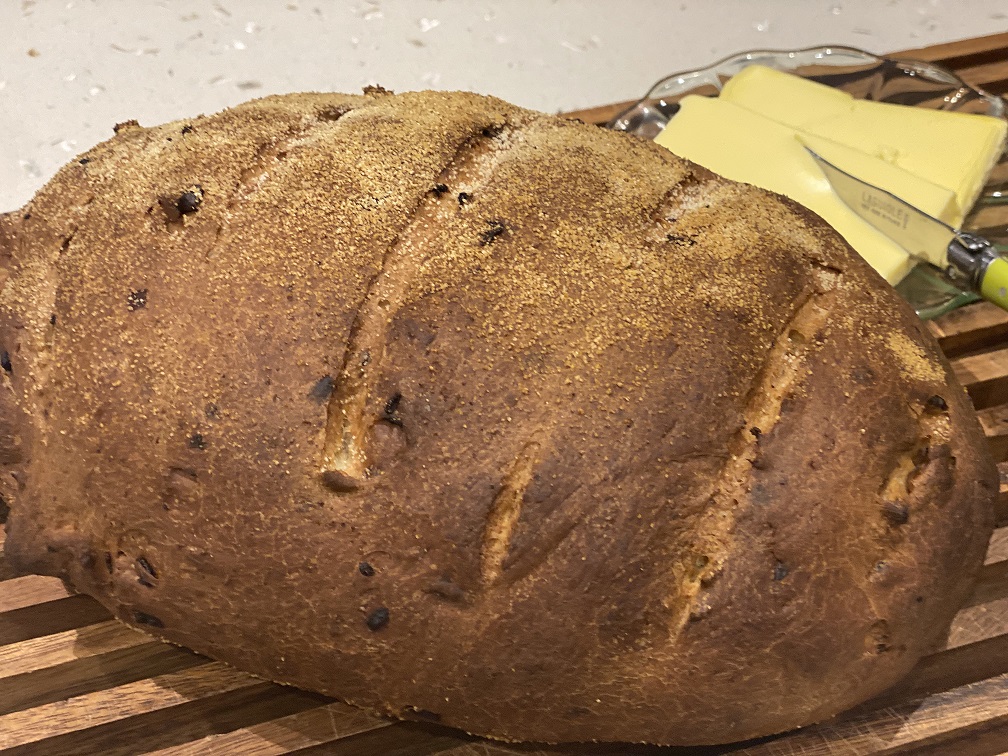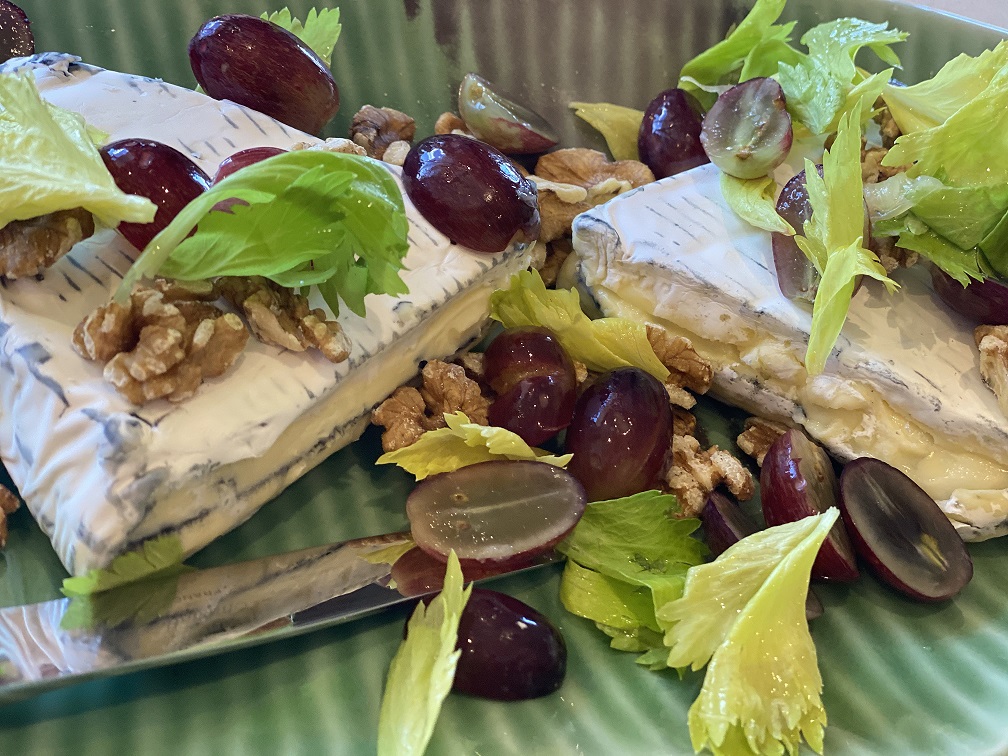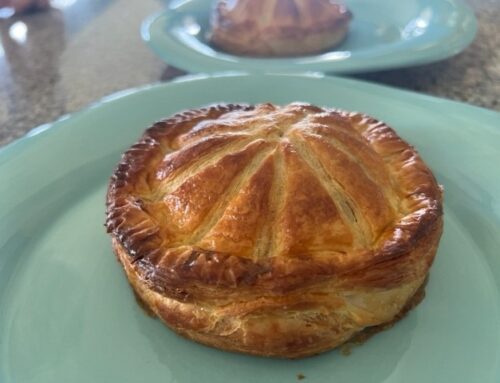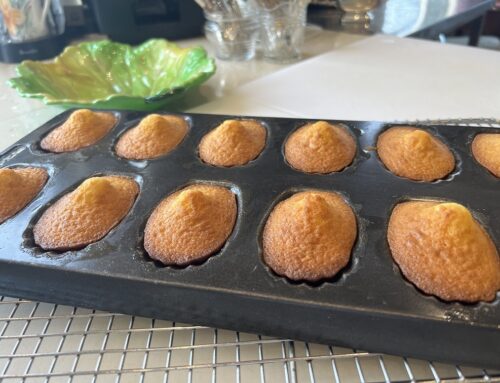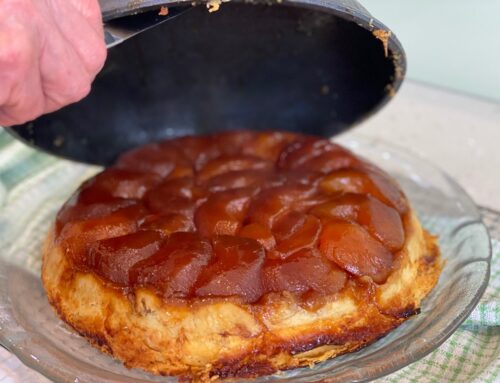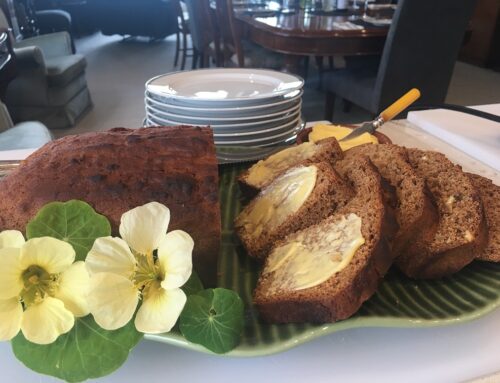I often bake this bread for the French Odyssey – Journey through France cooking classes, especially if we are making the walnut and Roquefort cheese terrine. Walnuts are grown widely in SW France, and when I was in the Dordogne with various culinary tours we always took the group to an ancient walnut mill and watched the making of their delicious and prized walnut oil. This versatile bread is served either fresh or toasted and is a wonderful accompaniment to cheese and wine, and to my walnut and Roquefort cheese terrine.
Makes one loaf
450g strong white bread flour OR 450g white flour plus 50g gluten
60g wholemeal flour
3 tsp salt
120g coarsely chopped walnuts
1 small onion finely chopped
1 tbsp extra virgin olive oil
15g compressed yeast or 10g dry yeast
250ml milk at room temperature
60g unsalted butter, at room temperature
160-200ml water at room temperature
2 tbsp cornmeal, polenta or semolina
Mise en place: weigh and measure all the ingredients. Sift the flours and salt into a large bowl and mix together.
Finely chop the onion and gently sauté it in a frying pan with oil and butter, for 10 minutes until caramelised and golden, without burning them; set aside to cool.
While the onion is cooking, coarsely chop the walnuts. If you have used a lot of olive oil, strain the onions; set oil aside and use for another use as onion flavoured olive oil. Set the onions aside.
For the dough: you need to re-activate the yeast. Take a small bowl, mix the yeast with 20ml milk to form a smooth mixture; wait for the yeast to re-activate and form bubbles in the mixture. Yeast is a living organism and when used, it needs to be re-activated, to ensure it is alive and be an effective raising agent in the bread.
Take the large bowl of dry ingredients, make a well in the centre, add the yeast mixture, into the well. Slowly add the remaining milk and softened butter, mixing with your hand.
Continue mixing the dough in the bowl adding the water, as necessary, slowly a little at a time to form a smooth elastic dough. Most likely you will not need all the water, so add it slowly to get the smooth, elastic dough. Dust with extra flour if the dough is too sticky. When the dough has formed, open a pocket in the dough and add the cold onion, without any excess oil and the walnuts.
Incorporate the onions and nuts by kneading and folding the dough. It should leave the sides of the bowl, and the bowl should be clean. You may not need to use all the nuts and onions, use what you think is ok for you.
To knead the dough: turn the dough onto a floured work surface and knead for 10 minutes. The rule of thumb is 10 minutes per kilogram and as we are kneading longer, the dough will rise better.
Push the dough out with the heel of your hand and then folding it over on itself, turning it by a quarter turn, 90℃, each time. Repeat this process for 10 minutes. It should feel beautifully silky and pliable.
Return to the bowl and cover with plastic wrap. Unless the weather is especially cold there is no need to place it in an especially warm spot. If you need a warm spot and can’t find one, stand your bowl in another larger bowl of hot water.
Prove the dough: let the dough prove until it has doubled in size; this usually takes 1 to 2 hours, again depending on various circumstances such as the air temperature, the age of the flour, and the activity of the yeast organisms.
Knock back the dough: once the dough has proved, it will look puffy and spongy. It now needs to be ‘knocked back’; that is punched down with your fist. A delicious smell of yeast comes from the dough; then gather it up, put the dough on the bench, with some sprinkled flour if necessary. Knead it as above, by pushing it out and then folding it over on itself, turning it by a quarter turn each time. Repeat this process 2 to 3 times. This ‘knocking back’ process redistributes the gas bubbles produced by the yeast, helps the gluten to develop and reinvigorates the yeast so that it forms new air pockets.
Form into a round or oval loaf: place the dough on a lightly oiled baking sheet; form it into a long oval shape or put into a bread or loaf baking tin, approximately 24cm x 14cm; sprinkle the dough with semolina and allow to prove again until doubled in size.
Pre-heat the oven to 210°C. Place a tray of water or ice cubes in the bottom of the oven if yours is not fitted with steam injection.
Slash the top of the loaf about 5 times with a sharp knife or razor blade. Bake for 20 minutes. Remove the pan of water.
Reduce the temperature to 160°C and bake a further 40 minutes or until it sounds hollow when tapped on the bottom.
Cool on a wire rack. When cold, wrap in a tea towel and store in airtight container.
The ancient, French 16th-century water mill, Moulin de la Tour, is still used to make walnut oil in Sainte-Nathalène, a tiny hamlet, near Sarlat in the Dordogne, southwest France.
When in France some years ago, I visited the ancient 16th-century water mill, Moulin de la Tour, in the tiny hamlet of Sainte-Nathalène on the edge of the small Enéa river, near Sarlat in the Dordogne, southwest France. The wheel of the mill turns an old-fashioned grinding mechanism that crushes the nuts under a huge stone and the resultant paste is heated before being pressed and filtered for its oil.
During our visit, they were processing the walnuts to make the precious, huile de noix, walnut oil. The owners are passionate about making these oils in a traditional artisanal manner. Watching the walnuts being crushed and seeing the oil dripping from under the massive stone into the receptacle was a slow but fascinating process. Sadly, these practices are disappearing.
- Walnut and onion bread
- Walnut and onion bread
- Walnut and cheese salad

